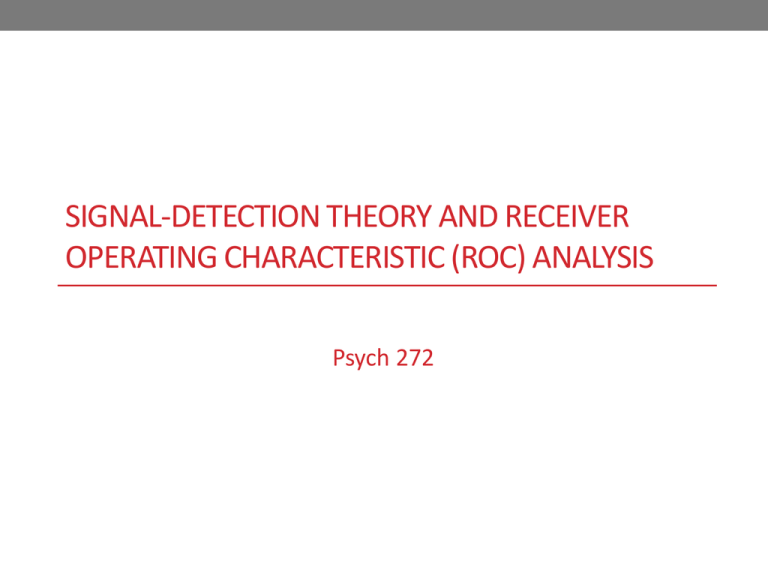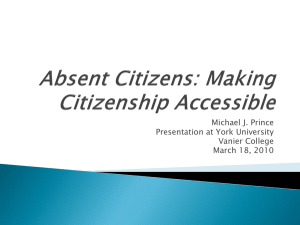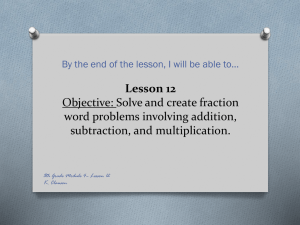Psych 272 (1)
advertisement

SIGNAL-DETECTION THEORY AND RECEIVER OPERATING CHARACTERISTIC (ROC) ANALYSIS Psych 272 Eyewitness Memory and Wrongful Convictions • Since the 1990s, DNA testing has overturned 318 wrongful convictions • Eyewitness misidentifications – which were invariably made with high confidence in a court of law – played a role in 75% of these cases • One of the most famous cases involved the misidentification of a man named Ronald Cotton The Case of Ronald Cotton • In 1984, a college student named Jennifer Thompson was raped • Shortly thereafter, she picked Ronald Cotton out of a photo lineup • "I was absolutely, positively, without-a-doubt certain he was the man who raped me when I got on that witness stand and testified against him. And nobody was going to tell me any different." • Cotton was sentenced to life in prison plus 54 years, and he served almost 11 years in jail before being exonerated by DNA testing Eyewitness Identification Procedures Simultaneous Lineup Suspect: Innocent or Guilty? Fillers: All are known to be innocent Eyewitness Identification Procedures Simultaneous Lineup Sequential Lineup Suspect: Innocent or Guilty? Lindsay & Wells (1985) Simultaneous lineup Correct ID rate = 0.58 False ID rate = 0.43 Sequential lineup Correct ID rate = 0.50 False ID rate = 0.17 .58 / .43 = 1.35 Diagnosticity Ratio .50 / .17 = 2.94 When does signal detection theory apply? 1. There are two true states of the world • An enemy plane is either present or absent in the sky • A disease is either present or absent in a patient • A guilty suspect is either present or absent in a lineup 2. An imperfect diagnostic procedure is used to make a decision (the target is "present" or "absent") • An air-defense radar system • A medical test • An eyewitness presented with a lineup 2 X 2 Table Diagnostic Decision Present Absent Present Hit (Correct ID) Miss Absent False Alarm (False ID) Correct Rejection True State 2 X 2 Table Diagnostic Decision Present Absent Present Hit (Correct ID) Miss Absent False Alarm (False ID) Correct Rejection True State 2 X 2 Table Diagnostic Decision Present Absent Present Hit (Correct ID) Miss Absent False Alarm (False ID) Correct Rejection True State 2 X 2 Table Diagnostic Decision Present Absent Present Hit (Correct ID) Miss Absent False Alarm (False ID) Correct Rejection True State 2 X 2 Table Diagnostic Decision Present Absent Present Hit (Correct ID) Miss Absent False Alarm (False ID) Correct Rejection True State 2 X 2 Table Diagnostic Decision Present Absent Present Hit (Correct ID) Miss Absent False Alarm (False ID) Correct Rejection True State 2 X 2 Table Ted Bundy Diagnostic Decision Absent Present Present Hit (Correct ID) Miss Absent False Alarm (False ID) Correct Rejection True State Innocence Project Ronald Cotton 2 X 2 Table Ted Bundy Diagnostic Decision Absent Present Present Hit (Correct ID) Miss Absent False Alarm (False ID) Correct Rejection True State Innocence Project Ronald Cotton 2 X 2 Table Diagnostic Decision Present Absent Present Hit (Correct ID) Miss Absent False Alarm (False ID) Correct Rejection True State Signal Detection Theory Continuous diagnostic signal Weak Signal Strong Signal Power of the reflected radio signal Blood Memory glucose strength level Signal Detection Theory: Response Bias “the guilty suspect is probably in the lineup” Weak Signal Strong Signal Signal Detection Theory: Response Bias “the guilty suspect is probably in the lineup” “absent” “present” Weak Signal Liberal response bias: Identify even if confidence is low Strong Signal Signal Detection Theory: Response Bias “the guilty suspect may or may not be in the lineup” Weak Signal Strong Signal Signal Detection Theory: Response Bias “the guilty suspect may or may not be in the lineup” “absent” Weak Signal “present” Strong Signal Neutral response bias: Identify if confidence is fairly high Signal Detection Theory: Response Bias “too many innocent suspects have been misidentified” Weak Signal Strong Signal Signal Detection Theory: Response Bias “too many innocent suspects have been misidentified” “absent” Weak Signal “present” Strong Signal Conservative response bias: Identify only if confidence is very high Signal Detection Theory: Discriminability Weak Signal Strong Signal Signal Detection Theory: Discriminability Target Absent (Innocent suspects) Weak Signal Strong Signal Signal Detection Theory: Discriminability Target Absent (Innocent suspects) Weak Signal Strong Signal Signal Detection Theory: Discriminability Target Absent (Innocent suspects) Weak Signal Target Present (Guilty suspects) Strong Signal Signal Detection Theory: Discriminability Discriminability Target Absent (Innocent suspects) Weak Signal The degree to which the memory signals associated with innocent and guilty suspects are separated using a particular diagnostic procedure Target Present (Guilty suspects) Strong Signal "Absent" Liberal "Present" Target Absent Target Present Strong Signal Weak Signal "Absent" Neutral Target Absent Target Present Weak Signal "Absent" Conservative "Present" Target Absent Weak Signal Strong Signal "Present" Target Present Strong Signal "Absent" Liberal: “the guilty suspect is probably in the lineup” "Present" Target Absent Target Present Strong Signal Weak Signal "Absent" Target Absent "Present" Target Present Weak Signal "Absent" Target Absent Weak Signal Strong Signal "Present" Target Present Strong Signal "Absent" Liberal: “the guilty suspect is probably in the lineup” "Present" Target Absent Target Present Strong Signal Weak Signal "Absent" Target Absent "Present" Target Present Weak Signal "Absent" Target Absent Weak Signal Strong Signal "Present" Target Present Strong Signal Correct ID Rate = 0.98 "Absent" Liberal: “the guilty suspect is probably in the lineup” "Present" Target Absent Target Present Correct ID Rate = 0.98 False ID Rate = 0.50 Strong Signal Weak Signal "Absent" Target Absent "Present" Target Present Weak Signal "Absent" Target Absent Weak Signal Strong Signal "Present" Target Present Strong Signal "Absent" "Present" Target Absent Target Present Strong Signal Weak Signal "Absent" Neutral: “the guilty suspect may or may not be the lineup” Target Absent "Present" Target Present Weak Signal "Absent" Target Absent Weak Signal Strong Signal "Present" Target Present Strong Signal "Absent" "Present" Target Absent Target Present Strong Signal Weak Signal "Absent" Neutral: “the guilty suspect may or may not be the lineup” Target Absent "Present" Target Present Weak Signal "Absent" Target Absent Weak Signal Strong Signal "Present" Target Present Strong Signal Correct ID Rate = 0.84 "Absent" "Present" Target Absent Target Present Strong Signal Weak Signal "Absent" Neutral: “the guilty suspect may or may not be the lineup” Target Absent "Present" Target Present Correct ID Rate = 0.84 False ID Rate = 0.16 Weak Signal "Absent" Target Absent Weak Signal Strong Signal "Present" Target Present Strong Signal "Absent" "Present" Target Absent Target Present Strong Signal Weak Signal "Absent" Target Absent Target Present Weak Signal "Absent" Conservative: “do not make an ID unless you are certain of being correct” "Present" Target Absent Weak Signal Strong Signal "Present" Target Present Strong Signal "Absent" "Present" Target Absent Target Present Strong Signal Weak Signal "Absent" Target Absent Target Present Weak Signal "Absent" Conservative: “do not make an ID unless you are certain of being correct” "Present" Target Absent Weak Signal Strong Signal "Present" Target Present Strong Signal Correct ID Rate = 0.50 "Absent" "Present" Target Absent Target Present Strong Signal Weak Signal "Absent" Target Absent Target Present Weak Signal "Absent" Conservative: “do not make an ID unless you are certain of being correct” "Present" Target Absent Strong Signal "Present" Target Present Correct ID Rate = 0.50 False ID Rate = 0.02 Weak Signal Strong Signal "Absent" "Present" Correct ID Rate = 0.98 Target Absent Target Present Weak Signal False ID Rate = 0.50 Receiver Operating Characteristic (ROC) Strong Signal "Absent" Target Absent "Present" Target Present Correct ID Rate 1.0 0.8 0.6 Correct ID Rate = 0.84 0.4 False ID Rate = 0.16 Weak Signal Strong Signal 0.2 0.0 0.0 0.2 0.4 0.6 0.8 False ID Rate "Absent" Target Absent "Present" Target Present Correct ID Rate = 0.50 False ID Rate = 0.02 Weak Signal Strong Signal 1.0 Receiver Operating Characteristic Analysis Target Absent Weak Signal Target Present Correct ID Rate 1.0 0.8 High discriminability 0.6 0.4 0.2 Strong Signal 0.0 0.0 0.2 0.4 0.6 0.8 1.0 False ID Rate Target Absent Target Present Weak Signal Strong Signal Correct ID Rate 1.0 0.8 Low discriminability 0.6 0.4 0.2 0.0 0.0 0.2 0.4 0.6 0.8 False ID Rate 1.0







